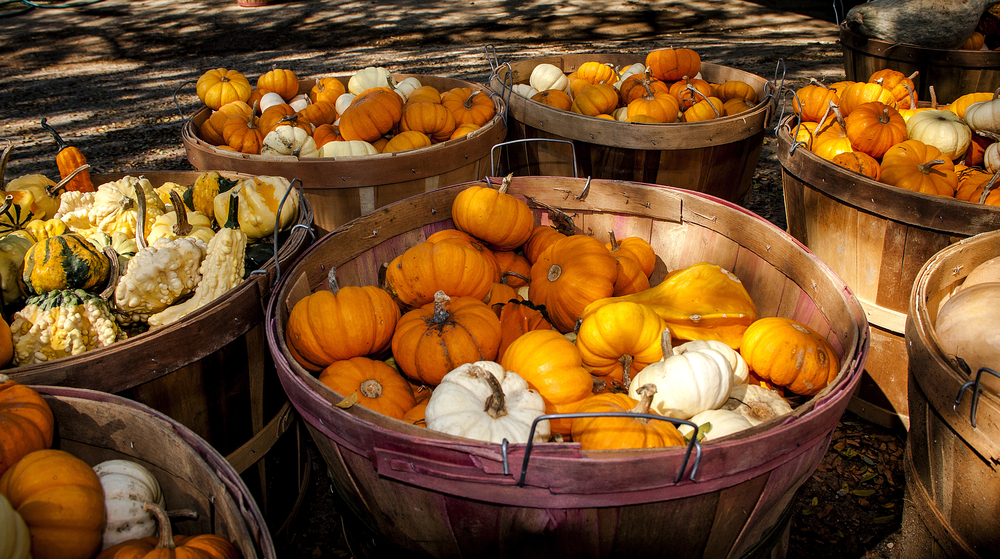
Pumpkins are commonly an icon for autumn and an American symbol for the Thanksgiving holidays. As October approaches, we can almost taste the pumpkin pie. About 80% of the pumpkin harvest in the United States occurs in the coming autumn month.
While pumpkins are related to the American Thanksgiving holiday, they were actually imported from south of the border. Some sources say that pumpkins came from South America and others says Mexico, but archaeologists found seeds in Mexico that they believe to be from a pumpkin that date from 7000 to 5500 BC.
Pumpkins are a cucurbit, classed in with squashes, cucumbers and even melons. They are also considered a fruit, having a mildly sweet taste that gourmets of the day enhanced with just the right blend of seasonings. Preparation varied, as Native Americans simply roasted strips of pumpkin over a fire and colonists invented the original pumpkin pie, which had no crust. They removed the top of the pumpkin and the seeds inside, and then filled the pumpkin with milk, spices and honey. The entire pumpkin was placed directly in hot ashes to bake.
Pumpkins would also become a decorative piece as a result of Irish arts and crafts. The Irish carved turnips into the likeness of what we recognize as a jack o’ lantern face as part of the festival of Samhain, which took place from sundown on October 31st to sundown on November 1st. On that night, which would be called Hallowe’en, observers of the holiday would place a candle into the carved turnip of gourd and set in on a windowsill of their home. Once Irish folk migrated to the North American continent, they found pumpkins easier to work with and chose them instead for their carvings. Hence, we have the tradition of jack o’ lantern carving.
The one big fail in the use of pumpkin was to attempt using it as a snake bite treatment. Colonial Americans learned the hard way that smashing pumpkin onto a snake bite wound would not save the victim’s life.
Americans have been in love with pumpkin for centuries. It is perhaps one of the most versatile foods available, giving a creamy texture to soups and moist goodness made into bread. As autumn draws near, food advertisements revolve around pumpkins, and every coffee shop carries some type of pumpkin latte or new pumpkin muffin or coffeecake.
Sizes of pumpkins depend on the species, and Cucurbita maxima is the variety that grows largest and produces the ideal pumpkin shape we envision. While all types vary in weight the largest pumpkin grown to date weighed 2,032 pounds! Quite massive for a fruit, but part of the extreme weight can be attributed to the fact that pumpkins are 90% water. The largest pumpkin pie ever made measured over 5 feet in diameter and weighed 350 lbs., and was made with 80 lbs. of pumpkin, 36 lbs. of sugar and 12 dozen eggs! Taking 6 hours to bake, this pie could have fed a couple of large families!
The flesh is not the only edible part of a pumpkin. The flowers can be enjoyed as part of a soup or sautéed with a mix of vegetables. The seeds can be saved from a fresh pumpkin and roasted with seasonings for a healthy on-the-go snack, following a very simple recipe:
Roasted pumpkin seeds
Preheat oven to 300 degrees F
Use prepackaged, dry, raw pumpkin seeds or remove the top of a fresh pumpkin and take out the seeds. Rinse them thoroughly and discard the connective fibers. Dry them in paper towels and place them into a bowl with enough melted butter to coat them, plus a pinch of salt. If you want to add a dash of tamari or soy sauce or even some spices, feel free to do so.
Arrange the coated seeds in a single layer on a baking sheet and bake in the oven for 45 min. or until golden brown.
Tip: You can line your baking pan with parchment paper for easy clean up.

